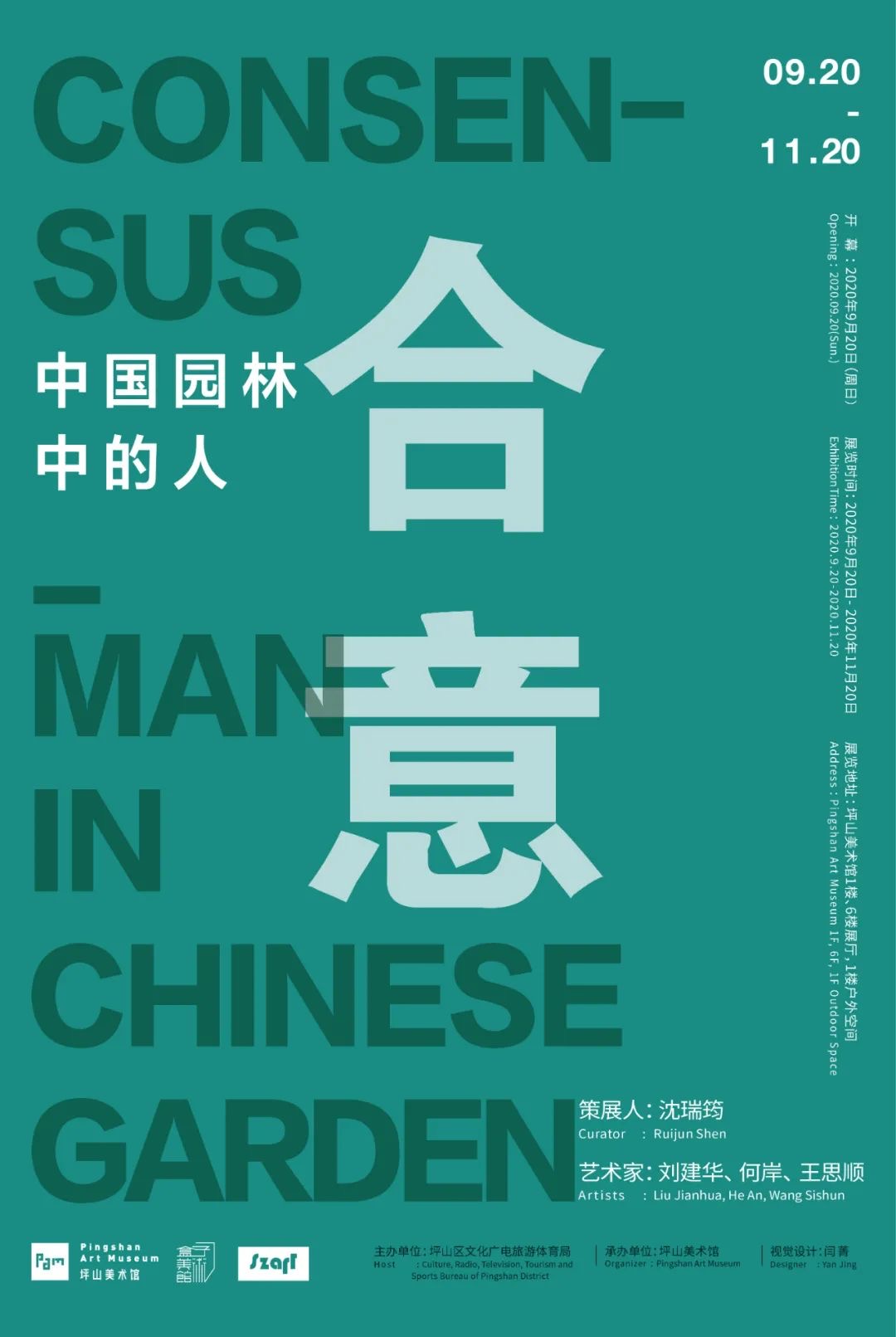在科技极速发展的今天,⼈在不知不觉中被速度和⼯具异化。我们创造的东西越多就越迷茫,⼈与环境的问题也越发显著。当我们在过量的信息、过快的生活节奏、无休止的欲望和都市生活所带来的压力前迷失时,是否想过自己的生命可能已被过份简单地量化?我们能否从更立体的维度来理解正在发生的事情?展览《合意——中国园林中的人》,试图以中国园林为切入点,探讨中国传统文化对人的理解和处理人与万物关系的方法,以挖掘其在当下的意义。
古代中国是一个农耕国家,农耕文明要求人把大自然的变化和人的行为联系起来。因此,中国哲学发展出天人合一,天人同构,天人感应的世界观。农业生产的经验使我们了解到保持万物平衡发展达到风调雨顺是获得好收成的重要保证。因此中国人崇尚中庸之道。“万物并育而不相害,道并行而不悖…… 此天地之所以为大也”(《中庸》第三十章)。《中庸》所描述的世界承认事物之间的多样共生的现象,人则要主动调和矛盾以达到人和万物和谐共存的理想结果。《黄帝内经 · 素问》有言 “人以天地之气生,四时之法成”。中国古代思想家并没有把人看作是造物主创造的物种,人和天地万物一样,由能量聚合而产生形体。因而人与万物能超越形体的障碍,相互感应,相互作用。大宇宙的变化会影响人内在小宇宙的运转,按照宇宙运行的规律行事,保持气的贯通,阴阳平衡,是身心健康的保证。因此主客合一的思想在中国哲学中很自然地得到发展。同时,因为对气的认识,在中国文化中,看不见的能量,例如神情、气韵、意味、虚空,受到特别的关注。诸如中国古代的园林和建筑空间通过营造意境使人的情感和景物产生共鸣,把空间的实用功能和人的感情需求结合,把人的精神寄托融入日常生活,把天地万物构想成一个多样统一,你中有我我中有你的世界,都是这种思想的具体体现。
在展览的前期调研中,策展人沈瑞筠携同刘建华、何岸、王思顺三位艺术家⼀起⾛访⼀些不常见的园林以及古建筑,对建筑和园林的空间布局,园林中的情感温度进⾏考察。这次展览是一次尝试,我们希望用当代艺术作品构建一种游历的体验,让观众在过程中获得认知。三位艺术家的作品各不相同:刘建华通过翻转材质的物质和视觉特性,质疑视觉所建构的固化认知的可靠性;何岸通过对工业部件的改造和重组使表面冰冷的材料产生微妙的叙事关系;王思顺通过石头来回应天人感应和天工开物的思想。艺术家针对展览主题订做作品或改变原有作品的形态,目的是成就彼此。我们设想的展览空间并不是置放作品的容器,展览也不是传递信息的工具。我们尝试通过处理空间和作品的关系来制造一种心境。展览以 “意” 和 “境” 的概念重构三位艺术家的作品,使作品之间互相穿插,互相呼应,互为意义;并由此形成不同形态和气质的空间,引发观众在观展的过程中产生此起彼伏的感受,探讨每位艺术家的作品在特定关系中所生成的意义。展览巡回到坪山美术馆,我们根据美术馆的空间重新调整了作品的形态以及布展方式,为观众呈现两个不同气质的空间。一楼使用人造光,神秘感性,牵动思绪;六楼采用纯自然光:展厅的明度随着时间的变化而变化,空灵寂静,引发人内心的对话。通过展览形态和特定空间的对话产生展览气质和所指的多义性在巡展的过程中得到进一步的体现。展览专门为坪山美术馆定制的户外园林《自留园》,在一个真实的园林中尝试把精神融入日常,挖掘珠三角交错共生的乡野审美。
With the rapid development of science and technology, people are unconsciously alienated by speed and tool. The more things we create, the more confused we are; the problems between people and environment are becoming more and more significant. Consensue – Man in Chinese Gardens tries to use classic Chinese gardens as an entry point to explore the interpretation of people in traditional Chinese culture and the methods of dealing with the relationships between people and universe.
Ancient China was an agrarian nation. Agrarian civilization naturally drew connections between changes in nature and human behavior. Thus, Chinese philosophy developed a worldview of unity between man and nature, sameness and reciprocity between man and nature. Experience in agricultural production has revealed maintaining harmonious balance among all things is a way to ensure a good harvest, and so Chinese people came to uphold the doctrine of the mean. “All things are fostered together without harming one another; the courses of nature unfold without colliding into each other… This is what makes heaven and earth so great” (The Doctrine of the Mean, chapter 30). The Doctrine of the Mean describes a world that accepts the phenomena of diversity and coexistence between all things. Humanity must respect the order of nature, learn from the openness and acceptance of nature as it nourishes all things, and actively seek to remedy contradictions to achieve the ideal outcome of harmonious coexistence with all things. The Inner Cannon of the Yellow Emperor—Plain Questions states: “People are born of the qi of heaven and earth, and molded by the order of the seasons.” Ancient Chinese thinkers did not see people as the work of Creator. People, like all things, are forms produced by the coalescence of energy. As such, people and things all have the ability to transcend the barriers of form and to engage with and mutually act upon each other. Changes in the greater cosmos will influence the operations of the lesser cosmos inside of people. By adjusting activities and relationships with the outside world according to the principles of the operations of the universe, and maintaining unobstructed flow of qi and balance between yin and yang, people can ensure mental and physical well-being. In this way, thinking which unifies subject and object naturally grew quite developed in Chinese philosophy. Meanwhile, due to this recognition of qi, certain unseen energies, such as demeanor, vital energy, implication and emptiness have been subject to a great deal of attention. The traditional Chinese gardens and architectural space-making bring out resonance between human emotion and scenery through creating a mindspace, integrate the practical function of the bridge with the emotional needs of the person, project the human spirit into everyday life, and consider the myriad things in the immerse world. These are all the embodiment of the thinking.
In the preliminary investigation of this exhibition, together with three artists, Liu Jianhua, He An, and Wang Sishun, we visited some unusual gardens and ancient architecture and investigated the spatial layout of architecture and gardens as well as the emotional temperature in the gardens. This exhibition is an attempt to use contemporary artworks to build the experience of travelling, so that the audience can obtain cognition during the process. We try to create a state of mind by dealing with the relationship between space and work. The exhibition reconstructs the works of the three artists with a concept of “mindscape”, so that the works can intersect each other, respond to each other, and support each other; thus forming a space of different shapes and temperaments, triggering the audience’s different experience, and exploring the meaning of certain relationship in each artist’s works. The touring exhibition came to Pingshan Art Museum. We re-adjusted the form and arrangement of works according to the space of the art museum, presenting two spaces with different qualities to the audience. Artificial light is used on the first floor to make the space mysterious and sensual, and touch the mind. The sixth floor uses natural light that changes with time to make the space ethereal and silent, triggering inner dialogue. The temperament of the exhibition through the dialogue between the form and the space, and the signified polysemy are further embodied in the touring exhibition process. The outdoor garden “Kitchen Garden“, specially commissioned for Pingshan Art Museum, tries to integrate spirit into daily life in a real garden, and explores the interlace and symbiosis rural aesthetics of the Pearl River Delta.

